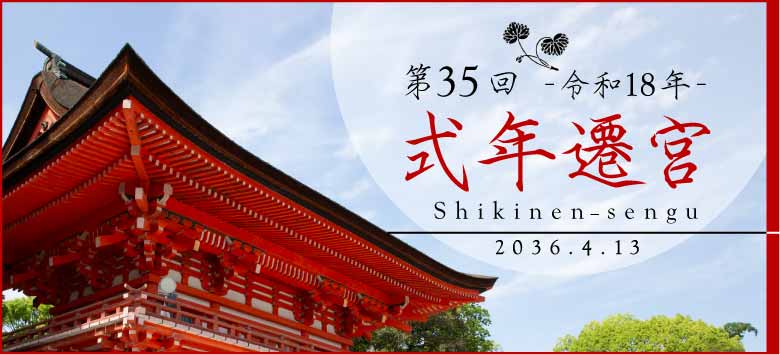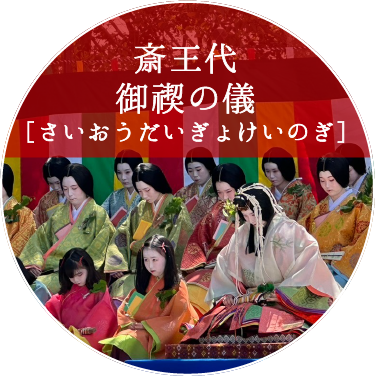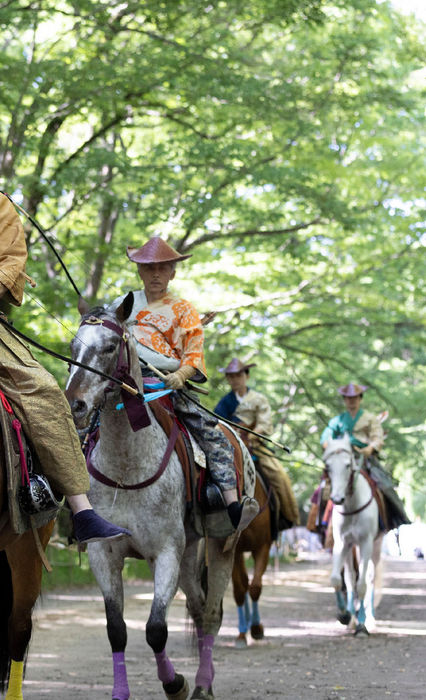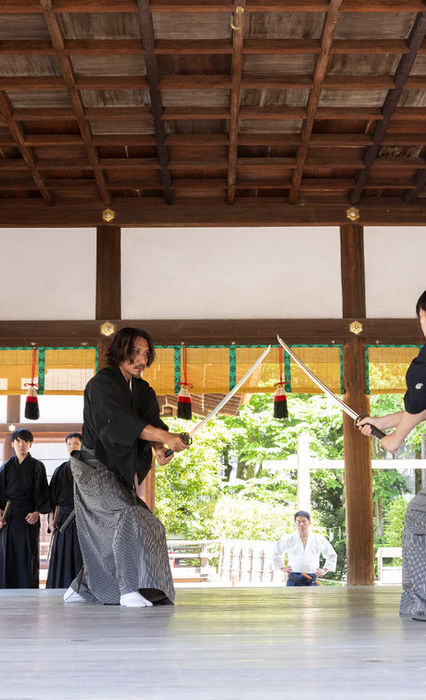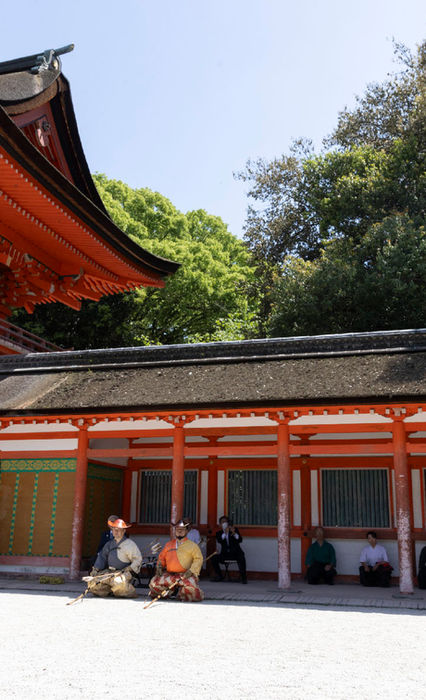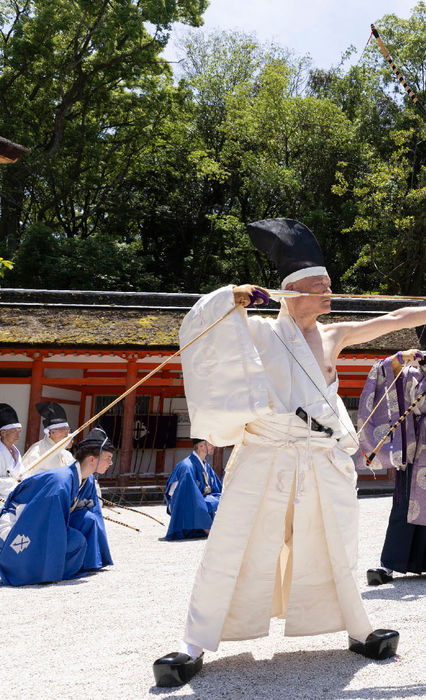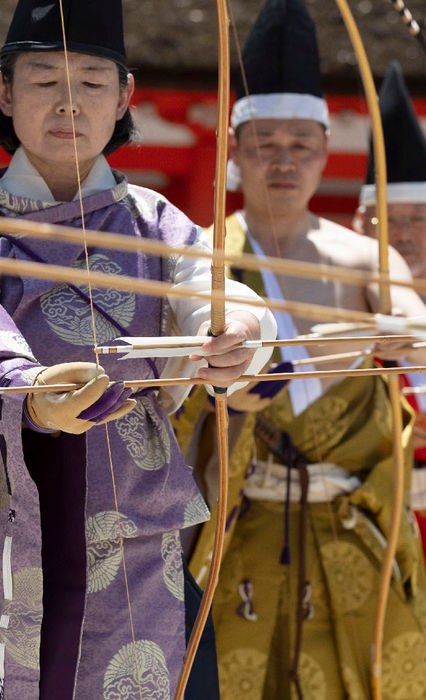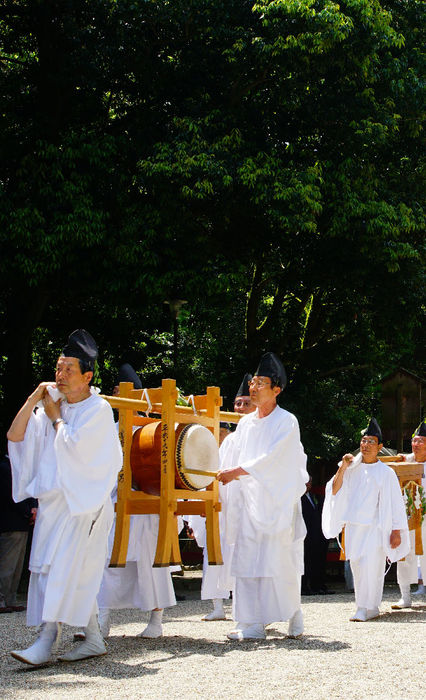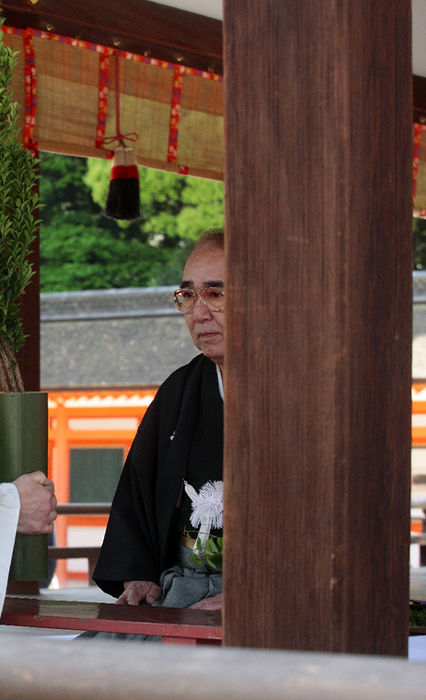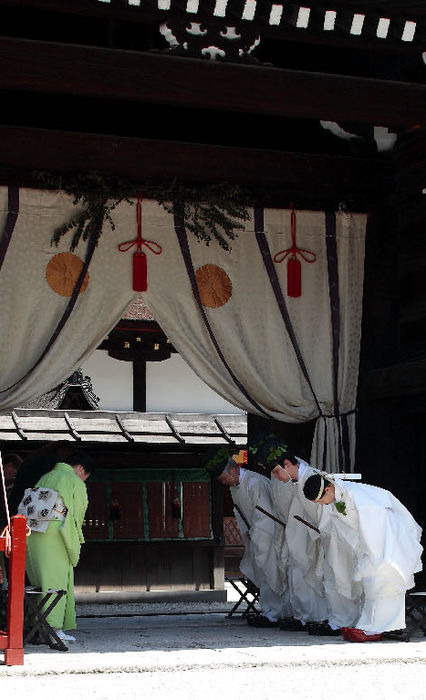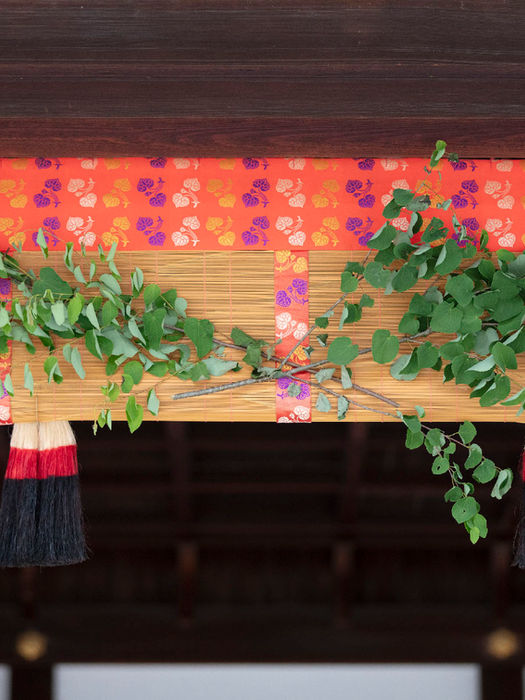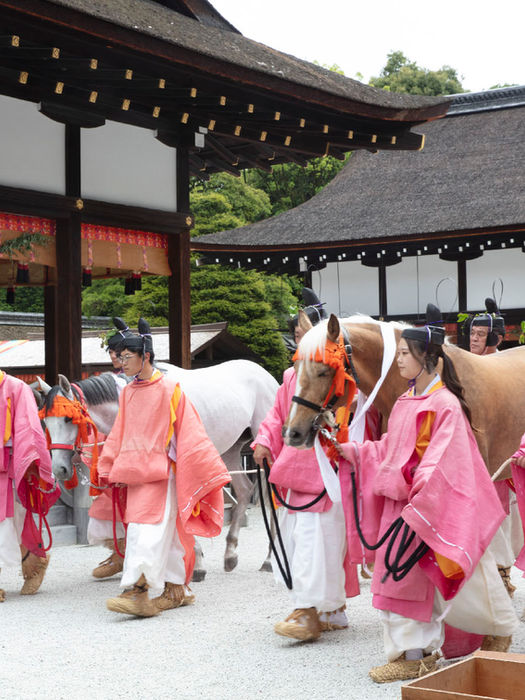Wedding ceremony application
Weekdays: 11:00am - 4:00pm Saturdays, Sundays and holidays: 10:00am - 4:00pm Phone reception: 0120-480-451



The Kamo Festival (Aoi Festival), held every year on May 15th, is said to have originated about 1,500 years ago (540-572), when Emperor Kinmei sent an imperial envoy to perform a festival for the "Kamo Gods" during a time of poor harvests and widespread famine and epidemics. It is the annual festival of both Shimogamo and Kamigamo Shrines, and is an "imperial festival" in which an imperial envoy, an angel of the emperor, serves. In ancient times, it was so deeply rooted in aristocratic society that when people spoke of "festivals," they meant the Kamo Festival (Aoi Festival). Even today, it is counted as one of Kyoto's three major festivals, along with the Gion Festival and the Jidai Festival.
The Kamo Festival is a festival to pray for the peace and security of the nation, and in order to fulfill this prayer, many religious ceremonies are held at Shimogamo Shrine in May.

*The Saiodai Misogi ceremony alternates between Kamigamo Shrine and the shrine every other year. In 2025, the ceremony will be held at Kamigamo Shrine.



place
Horse riding ground in Tadasu Forest (Map No. 45)
Visits by the general public
Possible
Application
Viewing: Free. Paid seats available. Applications are accepted only for same-day tickets. Applications will be accepted from noon on the day at Tadasu no Mori Kirishiba.
Yabusame is pronounced "yabusame" or "yabosame." It can also be written as "Yabuse-sha-uma." It is an event (Hashiru-ma-no-gi) in which archers dressed in hunting attire from nobles or samurai shoot arrows at targets from horseback. It is held prior to the main festival and signals the arrival of the Aoi Festival season.
This is a purification ritual held to pray for the safety of the Aoi Matsuri procession. It is a spectacular sight to see the archers galloping on horseback through the 400-meter riding ground in Tadasu Forest (along the approach to the shrine) and firing arrows at three targets. The target that the archer hits is awarded as a lucky charm, known as the "Atteki."
Back to the list of anterior and posterior symmetries

place
Mitarai Pond in front of Inoue Shrine (Map No. 17)
Visits by the general public
Possible
Application
Not required
Saio was an unmarried Imperial Princess who served the God of Kamo from the Heian to Kamakura period. Currently, she is called "Saio-dai" because a woman selected from the general public living in Kyoto serves as her representative. Prior to the Kamo Festival, she is called "Saio-dai" because she immerses her hands in the water of the shrine to purify herself. In the sacred grounds surrounded by green leaves, the Saio-dai, wearing a gorgeous twelve-layered kimono over a white omigoromo, innocent young girls, myobu in kosode, nyoju, naishi, and female betto, and the procession of over 50 women, accompanied by gagaku music, is reminiscent of an elegant imperial picture scroll.
Back to the list of anterior and posterior symmetries

place
Dance Hall and Bridge Hall
Visits by the general public
Yes
Application
Not required
Prior to the Kamo Festival, more than 30 schools of martial arts, including foreigners from all over Japan, will gather at the Kobudo Offering, where they will demonstrate the results of their daily training.
This is a rare opportunity to see first-hand ancient martial arts such as naginata, swordsmanship, jujutsu, iaido, as well as rare bōjutsu and kusarigama techniques.

place
Main Hall and Dance Hall
Visits by the general public
可能
Application
Not required
This is a Shinto ritual to ward off evil spirits, in which bows and arrows are used to purify the roads along the Aoi Festival. It originates from the Yabusame on the 3rd, in which arrows are shot on the ground, and is said to have originated from the "Jarai no Gi" (Archery Ceremony) that was held at the Imperial Court during the Heian Period.
The archers perform the "Hikimeshiki" ceremony, in which they sound their bows to ward off evil spirits from all directions, then the "Yagoshiki" ceremony, in which they shoot whistling arrows over the roof of the tower gate, the "Omatoshiki" ceremony, in which they shoot arrows at a large target, and the "Momoteshiki" ceremony, in which they shoot arrows in succession.
These four rituals are known as the "Meigenhikime Shinji" and are said to be a prayer for the safety of the Kamo Festival (Aoi Festival).
Back to the list of anterior and posterior symmetries

place
In front of the dance hall
Visits by the general public
Possible
Application
Not required
A dedication match between young kendo students. Brave voices echo through the temple grounds.
Back to the list of anterior and posterior symmetries

place
Main Hall and Dance Hall
Visits by the general public
Possible
Possible
Not required
The Tea Offering Festival is held as a sacred event to celebrate the Aoi Festival and appease the hearts of the gods. The three Senke Iemotos from Omote, Ura, and Mushakoji take turns serving. On the day, after a prayer is recited, thick and thin tea are prepared by the Iemoto in the dance hall and offered to the altar. Side seats, outdoor tea seats, and dim sum seats are also set up, and the temple grounds are filled with people in traditional Japanese clothing, creating a festive atmosphere. In 2025, the Urasenke will be serving the event.
Back to the list of anterior and posterior symmetries

place
Shimogamo Shrine - Okageyama - Kamohari Shrine - Shimogamo Shrine
Visits by the general public
Only the following rituals are possible:
Gyosho, Rojisai (Kamohari Shrine), Kirishiba Shinto Ritual
Application
Not required
Mikageyama at the foot of Mt. Hiei is where Mikage Shrine is located, where the Aramitama, the deity of Shimogamo Shrine, is enshrined. It is said that a new divine spirit will be born at Mikage Shrine on May 12th, and a Shinto ritual is held to welcome this divine spirit to the main shrine. This festival is said to be the oldest divine procession in Japan, and is famous as a festival that conveys the ancient form of faith in which the divine spirit is transferred to the main shrine on a sacred horse. The Mikage Festival is also made up of several Shinto rituals.
First, at the Shimogamo Shrine Dance Hall, the Kanpai Ceremony and Juge Shinji Ceremony are held, after which a procession (dressed in gyosho) of priests, parishioners, and others departs from the Tower Gate and parades to Mt. Mikage.
When the procession arrives at Mikage Shrine on Mt. Mikage, a ceremony is held to transfer the spirit of the deity that will be born at noon.
The divine spirit descends the mountain accompanied by its makeup and then arrives at Kamohani Shrine (Red Shrine), where a roadside ceremony is held and a dance piece called "Genjoraku" is dedicated.
The divine spirit is transferred to a sacred horse in the northern part of Shimogamo Hondori, and travels south along Shimogamo Hondori to Shimogamo Shrine. On the way to the main shrine, a song praising the god is performed in front of the sacred horse at Kirishiba in Tadasu no Mori, accompanied by dancing (Kirishiba Shinto Ritual). After proceeding to the main shrine, the divine spirit becomes one with the divine spirit of Shimogamo Shrine, and its power is enhanced.
Back to the list of anterior and posterior symmetries

place
Torii gate to main hall
Visits by the general public
Possible
Application
Not required
This Shinto ritual, which takes place on the day before the Aoi Festival, involves offering crucian carp caught in Lake Biwa from the Katata area of Otsu City, Shiga Prefecture, and is an event that has been held since the late Heian period.
On the morning of the day, the procession will receive prayers at Izu Shrine and Kanda Shrine in the Katata area, then parade through the area before arriving at Shimogamo Shrine by bus.
The long procession of people dressed in various costumes, carrying chests filled with crucian carp, drums, and village folk, passing through the Tadasu Forest and heading to the main shrine gives a glimpse of the people's prayers that have continued since the Heian period. The crucian carp that will be offered at the Aoi Festival on the 15th is dedicated here.
Back to the list of anterior and posterior symmetries

place
Dance hall
Visits by the general public
Possible
Possible
Not required
The Enshu head family, who have inherited the graceful gestures of Sadamatsusai Yoneichima, arrange fresh flowers (wooden items) with all their heart and soul and offer them in front of the altar of this shrine. This is a ceremony to console the great deity Kamo, attended by the disciples.
Back to the list of anterior and posterior symmetries

place
maiden
Visits by the general public
Possible
Application
Not required
The festival concludes with a dedication ritual in which sencha tea is offered to the gods. In the dance hall, the head of the Ogawa school solemnly brews a cup of tea using white porcelain and white clay utensils, and the priest offers it to both the western and eastern deities.
Back to the list of anterior and posterior symmetries

place
maiden
Visits by the general public
Possible
Application
Click here for more details.
The "Tadasugawara Kanjin Sarugaku," which was performed in front of Shogun Ashikaga Yoshimasa and other feudal lords about 550 years ago, has been revived for the first time in 550 years on the occasion of the 34th Shikinen Sengu Ceremony of Kamo Mioya Shrine. Kamo Mioya Shrine will celebrate its 35th Shikinen Sengu Ceremony in 2026, and the performance is held in late May every year as a part of its support. The 10th Tadasu Noh performance in 2025 will feature a new Noh piece, "Tadasu," being performed in the run-up to the Sengu Ceremony.
Back to the list of anterior and posterior symmetries


place
Kyoto Imperial Palace - Shimogamo Shrine - Kamigamo Shrine
Visits by the general public
Only the following rituals are possible:
Roadside Ceremony and Shrine Ceremony
Application
Not required.
The Kamo Festival still retains the ancient style of the Heian dynasty. Everything from the imperial envoys and attendants' clothing and headgear to their horses and cattle is decorated with hollyhock leaves, and it is said that the festival got its name from the fact that hollyhocks imbued with the power of the gods were presented at the end of the festival. The festival is divided into three parts: the Imperial Court Ceremony, the Road Ceremony, and the Shrine Ceremony. The best-known part is the Rotou no Gi, the highlight of the festival, and is the procession along the Miyako-oji street. The roughly 1 kilometer long procession departs from the Kyoto Imperial Palace in the guise of Heian aristocrats, and the elegant procession travels a total of 8 kilometers through the city, arriving at Shimogamo Shrine and then on to Kamigamo Shrine.
point
The annual festival of Kamigamo Shrine and Shimogamo Shrine. It is one of the "Three Imperial Festivals" (Imperial Festivals = festivals held by an envoy of the Emperor) "Kamo Festival, Kasuga Festival, Iwashimizu Festival". It is also recognized as one of the "Three Great Festivals of Kyoto" along with "Gion Festival" and "Jidai Festival".
The "Roto no Gi" procession leaves the Kyoto Imperial Palace and heads to both Shimogamo and Kamigamo shrines, featuring the beautiful costumes of the Saio-dai and other officials. You can experience the techniques of traditional industries in Kyoto, where the culture of the dynasty remains strong.
Its graceful appearance is praised as the festival of festivals in this country in "The Pillow Book", and it is also famous for the "carriage fight" scene in "The Tale of Genji". It is one of Japan's representative festivals, which has been continuing for about 1500 years.
A Shinto ritual at Shimogamo Shrine

This is the route to the "Shato no Gi" ceremony, where imperial envoys make offerings at Shimogamo and Kamigamo shrines and recite ritual texts. The sights are of the costumes and decorations that are reminiscent of imperial scrolls, such as the Konoe envoys in formal robes and the Saio in a twelve-layered kimono. The traditions supported by Kyoto's traditional industries and honed by the craftsmanship of the artisans are still alive.
The "Rodogi" ceremony has two main processions.


Centered around the Konoe Shidai, who acted as an imperial envoy.
It is made up of a guard procession of Kebiishi and others, a procession of offerings to the gods, a procession of runners, and a procession of imperial messengers. In the center of this procession is the Konoezukai, dressed in a black formal attire and riding a decorated horse.

Kebiishi
(The Activity of Kebiishi)

Gohei-bitsu (a traditional Japanese box of offerings)
(Prayer)

Ox cart
(Gisha)


Those who believe that the Saio-dai was the center
The Saio is originally an unmarried princess, and her representative, the Saio-dai, also wears a twelve-layered kimono and rides in a palanquin called an "Oyoyo." The Saio-dai procession is basically made up of women.

Saio-dai
(Saitama)

Horsewoman
(Munanorionna)

Lady
(Myoubu)

The Imperial envoy makes an offering to the Kamo deity and recites a ritual text. In accordance with ancient rituals from the Heian period, offerings, Bugaku dance, Touyu, and horseback riding are performed. After the ceremony at the shrine, the "Sōme no Gi" (Horse Running Ritual) is held at the riding ground in Tadasu no Mori, where several horses gallop repeatedly.
The main route of the "Rodo no Gi" ceremony

Awarding of red seals and amulets related to the Aoi Festival
Shimogamo Shrine will be awarding the "Shikimori Aoi" (four seasons guardian aoi) in honor of the Kamo Festival (Aoi Festival) that begins on May 1. In addition, on the day of the Kamo Festival (Aoi Festival), a limited edition goshuin (shrine seal) with "Aoi Festival" written on it will be awarded.

The photo is of a written note. We also accept stamps on the notebook.
*If you stamp the notebook, the picture of Aoi Katsura will not be included.
*Design may change without notice.

"Shikimori Aoi"
This is the specification for the 2025 fiscal year.



